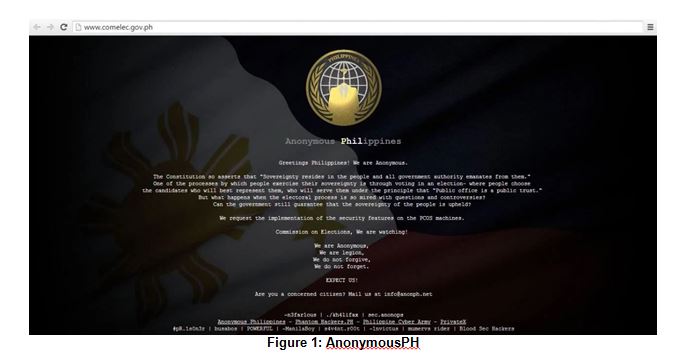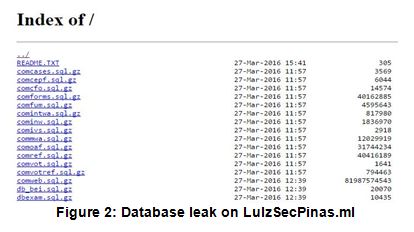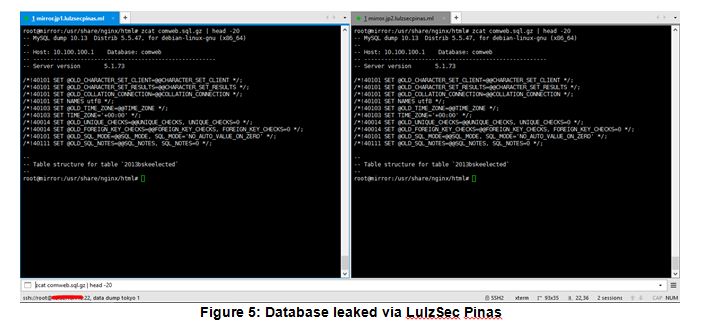Hackers assaulted the website of the Philippines' elections commission to protest both the integrity of the upcoming presidential elections in addition to security concerns regarding the electronic voting. The website was hacked and defaced on Sunday, March 27th by AnonymousPH, and a few hours later was assaulted by another group of hackers - LulzSec Pilipinas – which hacked and dumped the database of COMELEC voter's polls.
Download a Copy Now
Abstract
Hackers assaulted the website of the Philippines' elections commission to protest both the integrity of the upcoming presidential elections in addition to security concerns regarding the electronic voting. The website was hacked and defaced on Sunday, March 27th by AnonymousPH, and a few hours later was assaulted by another group of hackers - LulzSec Pilipinas – which hacked and dumped the database of COMELEC voter's polls (see Figure 1).
The attackers questioned the security measures taken by COMELEC to secure votes and voters' data for the upcoming May 9th national elections. In addition to the defacement, they published the poll database. The commission responded by promising that the election website will be hosted somewhere else and have its own set of security features which are of a higher quality.
Beyond the general concern to election voting systems, this event demonstrates the power hackers have and stresses the importance of having DDoS protection solutions in place. These type of attacks also have the potential to lead to psychological bias of voters, reduce election participation rates, undermine governing party's support, and more.

Background
- The hackers questioned both the integrity of the upcoming elections as well as the security measures taken in order to protect voters' private information. They demanded legitimate election results and threatened to remain vigilant in watching how COMELEC will be running the elections.i
- They specifically referred to securing the PCOS (Precinct Count Optical Scan) machines.
- These attacks followed a court ruling requiring the polling body to activate the voter verification audit trail so that they can produce voter receipts on the May 9th election day.
- Following the defacement by AnonymousPH, the hacktivist group LulzSec Pilipinas hacked and dumped COMELEC's database on their website, LulzSecPinas.ml. This leak included several databases including an 81Gb file (see Figure 2).

COMELEC spokesman James Jimenez stated the database leaked on social media sites was available for public use and no sensitive information was stolen.ii COMELEC indicated their IT department and web team is working to restore the database and searching for any malware the attackers may have left behind.
Reasons for Concern & to Have DDoS Protections Solutions in Place
These attacks appear to have one main purpose: to spread fear that the polling systems that will be in the upcoming presidential elections are just as insecure as the COMELEC website. It could potentially influence the election's results.
Defacements and data dumps can cause reputation loss along with financial, and in this case, political damage. Over the last year, hacktivists have increased activity around social and political issues. Given the amount of media attention these DDoS attacks attract; they serve as fodder for cyber-attacks. Protests and political uproars have now taken to the digital world where hacktivists work to spread their message through defacements, SQL injection and denial of service attacks which has led into the increase of government services searching for DDoS protection solutions.

Organizations Under a Cyber Threat Should Consider
Effective DDoS protection solutions:
- A hybrid DDoS protection solution that combines on premise detection and mitigation with cloud-based protection for volumetric attacks. It provides quick detection, immediate mitigation and prevents internet pipe saturation.
- Solution must distinguish between legitimate and malicious traffic, protect the SLA and block the attack.
- An integrated, synchronized DDoS protection solution that can protect from multi-vector attacks combining DDoS with web-based exploits such as website scraping, Brute Force and HTTP floods.
- A cyber-security emergency response plan that includes an emergency response team and DDoS protection solutions and process in place. Identify areas where help is needed from a third party.
Effective Web Application protection elements (against web intrusions, defacement and data leakage):
- IP-agnostic device fingerprinting – Having the ability to detect attacks beyond source-IP using by developing a device fingerprint that enables precise activity tracking over time
- Automatic and real time generation of policies to protect from Zero-day, unknown attacks
- Shortest time from deployment to a full coverage of OWASP Top-10
Radware's hybrid attack mitigation solution provides a set of patented and integrated technologies designed to detect, mitigate and report todays most advanced threats. Dedicated hardware and cloud based DDoS protection solutions protect against attacks in real time and help ensure service availability.
Under Attack and in Need of Expert Emergency Assistance?
Radware offers a full range of DDoS protection solutions to help networks properly mitigate attacks similar to these. Our attack mitigation solutions provide a set of patented and integrated technologies designed to detect, mitigate and report todays most advanced DDoS attacks and cyber threats. With dedicated hardware, fully managed services and cloud solutions that protect against attacks, Radware can help ensure service availability. To understand how Radware's attack mitigation solutions can better protect your network
contact us today.